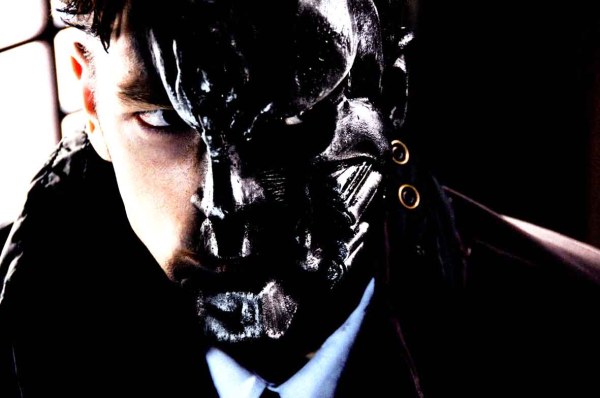Seeing as Tetsuo: The Bullet Man has begun floating around the torrentsphere, I thought I would take a look at the Tetsuo Trilogy and hopefully push a few people to start viewing it from the beginning before their interest is decayed by its contemporary counterpart.
Tetsuo: The Iron Man (鉄男: Tetsuo) is a 1989 Japanese Cyberpunk film by cult-film directorShinya Tsukamoto produced by Japan Home Video. This, his third film, is an extremely graphic but also strikingly-filmed fantasy shot in the same low-budget, underground-production style as his first two films. Tetsuo established Tsukamoto internationally and created his worldwide cult following.
To this day the film is still recognised as one of the most visually arresting Cyberpunk movies that has ever been made. It is often referred to as the love child of Lynch and Cronenberg, but this statement forgets the level of deformity and fetish that Tsukamoto brings to the plate (quite literally, as he plays the role of the Metals Fetishist in the movie). His presence onscreen and offscreen infects the film with a severe level of absurdity and confusion. This force feeds a relationship to the viewer, as they sit there enraptured in the film’s gritty-decadence. Few films have ever managed to grab my attention so much and when I try to think of ones to put on par in terms of shock value all I can think of are films like Wiseman’s,Titicut Follies and Resnais’, Fog and Night. This comparison is a strange one, as the films in question are documentaries, whilst Tetsuo: The Iron Man is obviously a work of fiction. It seems to me that somewhere amidst the world Tsukamoto created, he manages to capture the innate fear that surrounds the ever growing relationship between man and machine. Like a bad nightmare it lingers on leaving behind a cataclysmic wave of ambiguity. At this point the true power of this film becomes apparent.
Tetsuo II: Body Hammer is a 1992 Japanese science fiction/body-horror film directed by Tsukamoto. It is a bigger-budget reworking of his original Tetsuo: The Iron Man, utilizing similar themes and ideas to the earlier film (a Japanese salaryman, played by cult actor Tomorowo Taguchi, finds his body transforming into a weapon through sheer rage after his son is kidnapped by a gang of violent thugs.) It was not as well received as its predecessor but it did win the Critic’s Award at the 3rd Yubari International Fantastic Film Festival in February 1992
Like any other movie that ends up amassing a worldwide cult following a sequel was always inevitable. Tsukamoto’s choice to do a reworking of the original movie instead of a full on sequel gave him the leeway he needed to experiment with the film somewhat. Some of the changes in the film are still argued over to this day as being responsible for its sheer banality in comparison to its predecessor, whilst at the same time being heralded as the true visual, that budgetary constraints originally restricted. The biggest of these shifts is the moveTsukamoto made from monochromatic black & white to an extensive palette of colors. This combined with the introduction of more dialogue, literally divided the camp of cult followers. I feel that the changes Tsukamoto made present us with a new world of equal visceral importance, but is one that doesn’t allow its origins to be forgotten. For this reason I feel that it is an excellent companion piece to the Tetsuo trilogy, although for the best experiene I’d recommend watching them in chronological order.
Last, but not least we have the most recent version of tetsuo that is due for general release this year. 8 years after Tsukamoto’s powerful reworking and addition to his original masterpiece, the world is now just on the brink of being introduced to Tetsuo: The Bullet Man. As alluded to in the beginning, there is an overall concern amongst fans of the series that this new film may erode and give the previous two films a bad name. One of my main concerns for it is that it is definitely in danger of falling into the same category as the movies that have been spawned by the recent trend of American remakes of Japanese horror movies. The only thing stopping this from becoming a cot death is the fact that it is only co-produced by an American company. This allows for some of Tsukamoto’s artistic integrity to remain, but many viewers feel that it is now over stylised and its production values have sanded and polished away most of the gritty edge that this series is famous for in the first place. Obviously in terms of the main character the movie now follows the *INSERT AMERICAN HERE* protocol with the introduction of an American protagonist called Anthony. At times this film really feels like something that didn’t need to be made and this does worry me. Obviously the first two films are now so rooted as the cult phenomenon that they are, that their integrity at this stage is obviously pretty much infallible, but lets just hope that this is a differentiation that future followers will be able to make. I fear that these bastardized Western interpretations or Western ‘friendly’ versions of famous Japanese movies are a form of Cultural Imperialism. This may one day be the catalyst for such cyberpunk gems, becoming a discarded artifact of a throw-away society that no longer has the time to appreciate fine cinema. Let’s hope its not…


No comments:
Post a Comment